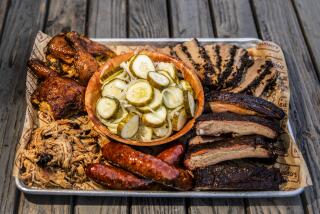A Kernel of Sugar
- Share via
Having been raised buying cachapas from vendors on the street and at the beach in Venezuela, I was excited to see your article on them (“The Eternal Cachapa,” Sept. 29). As a teenager, I liked cachapas so much that I experimented in the kitchen until I’d figured out how to make them (as a gringo, I had no family recipe to refer to).
When I came to live permanently in the States, I tried to make cachapas the same way I had in Venezuela (i.e., fresh corn ground in a blender plus a little milk, sugar and salt to taste), but they came out like mush.
The difference between here and there, I realized, is that their cachapa is made from what here is called field corn--i.e., corn that here is grown only to be dried on the stalks and then fed to animals headed for the slaughterhouse.
In the States it’s impossible to find fresh field corn for sale; the only corn sold fresh is sweet corn, grown specifically to be cooked and eaten by people. Whereas fresh field corn is pleasantly chewy, with a firmness throughout the kernel, fresh sweet corn has a much higher juice content, which is why, to be made into cachapas, it must be “fortified” with fine corn meal. (In the cachapas I make now, I also use a little wheat flour to get the cachapa closer to the consistency I remember from when I used to make them as a kid.)
Last evening I tried the recipe you provided, but I’ve got to say that the result didn’t taste like any Venezuelan-made cachapa I’ve eaten. For one thing, it was much too “eggy.” One egg white would be almost more than enough for that recipe, for lightness, but any more than that is overwhelming. I’ve never tasted an authentic cachapa that had even a hint of egginess. Plus, the recipe calls for far too much sugar, given how much natural sugar sweet corn already contains.
RICHARD IRWIN
From the Internet
More to Read
Eat your way across L.A.
Get our weekly Tasting Notes newsletter for reviews, news and more.
You may occasionally receive promotional content from the Los Angeles Times.








